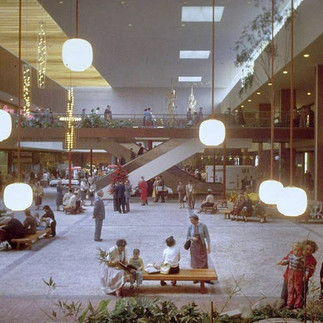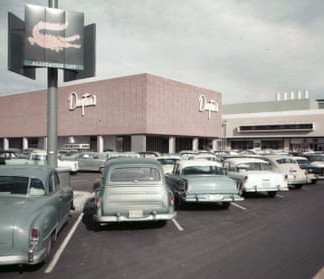How the Shopping Mall Became the Social Center of the Mid-Century—And Beyond
- Jess Taylor

- Apr 9
- 5 min read
Updated: Jun 8
Before Amazon wish lists and TikTok trends, the shopping mall was the place to be. Whether you were grabbing a milkshake at the food court, flipping through records at Sam Goody, or meeting friends at the arcade, malls were more than just shopping destinations—they were social hubs that shaped several generations.

The Birth of the Shopping Mall
The modern shopping mall was born out of the post-war boom when families left crowded cities for sprawling suburbs. Once the heart of downtown shopping, department stores needed a new home—and enclosed shopping centers provided a climate-controlled, car-friendly solution.
The very first enclosed mall, Southdale Center in Edina, Minnesota, opened in 1956 and still remains open today. It was designed by Austrian architect Victor Gruen, who set the blueprint for malls to come..
✔️ Anchor stores (Sears, JCPenney, Montgomery Ward)
✔️ Boutiques & specialty shops
✔️ Food courts & diners (Woolworth’s lunch counter, Orange Julius)
✔️ Entertainment spaces (movie theaters, skating rinks, arcades)
Southdale Center, 1956. Photos borrowed from The Guardian and Business Insider.
By the 1960s and 1970s, malls were no longer just a place to shop—they were social spaces. New shopping centers were popping up all across America. Malls adapted to changing fashion and social trends, with record stores, hippie boutiques, and even indoor gardens and fountains to create an inviting atmosphere. This was the golden age of the shopping mall, where families, couples, and teens spent hours browsing, eating, and simply being part of the social scene.


The 1980s: The Golden Age of the Mall
If the 1950s and 60s gave birth to the mall concept, the 1980s made it iconic. Malls weren’t just successful—they were everywhere. At their peak, nearly 16,000 malls exploded across the U.S., and they became as much a part of American life as Saturday morning cartoons and roller rinks.
Why Were Malls So Huge in the ‘80s?
🛍️ More disposable income: Baby Boomers had stable jobs and teenagers had money to spend.
🎶 Pop culture influence: From music videos to movies (Fast Times at Ridgemont High (82), Tiffany- I Think We're Alone Now music video (87), malls became a backdrop for youth culture.
🏬 Bigger, flashier, and more entertainment-focused: Malls were no longer just clusters of stores—they became mega-malls.
The Rise of the Mega-Mall
The 1980s saw the opening of massive shopping centers designed to be the all-in-one entertainment destination. The most famous of these was Mall of America (Minnesota, built in 1992), a 5.6 million square-foot giant, featuring an indoor amusement park, aquarium, and over 500 stores. I was lucky enough in my childhood to visit the Mall of America many times on my yearly family summer vacations to Minnesota.

For teens, malls were the ultimate hangout. You didn’t go only to shop—you went to:
🎳 Play arcade games at Aladdin’s Castle
📀 Flip through cassette tapes at Sam Goody
🥤 Grab a Cinnabon or an Orange Julius
👗 Try on prom dresses
🎥 See a blockbuster at the mall cinema
The ‘80s mall experience was about freedom. If you were a teen, you begged your parents to drop you off with your friends, where you could shop, gossip, and feel cool for a few hours before getting picked up at the food court.
The 1990s: Peak Mall Culture
By the 1990s, malls had reached their absolute peak. They were bigger, busier, and deeply embedded in pop culture. From sitcoms (Saved by the Bell) to music (Tiffany’s mall tour), malls weren’t just places to shop—they were a defining part of youth identity.
As an 80s baby and 90's youth, I feel this to my soul. Being in junior high in the mid-late 90s, the mall was the place to go. The days before cell phones meant being dropped off at the door and told to be back at that door at 5pm. It meant having change for the pay phone to beg your mom for more time. It was total freedom that kids today don't have. It was also such a different world back then.
My years of mall shopping started in the 80s, going weekly with my mom and grandma. It continued in the early 90s with my mom taking me to Walden's to get the new Fear Street book and my grandma taking me to KB Toys for new Barbie toys. In 1996, my first date with, to see 101 Dalmatians at the mall cinema, ice cream at Baskin-Robbins and shopping through the mall where he bought me a Beanie Baby (Velvet the black panther) at G-Thanks. I still have that Beanie Baby too.
What Made ‘90s Malls Special?
🛒 The explosion of teen fashion stores – Forever 21, Hot Topic, Delia’s, and Abercrombie & Fitch became must-visit destinations.
🎤 Mall concerts & celebrity appearances – Pop stars like Britney Spears and NSYNC performed at shopping centers across the country.
💿 CD stores & music culture – Virgin Megastore and Sam Goody were the places to grab the latest album before streaming existed. My favorite local stores were Camelot, Coconuts and Quonset Hut.
🍔 The peak of food court culture – Sbarro pizza, Panda Express, and Auntie Anne’s pretzels were iconic.
🕹️ Malls embraced gaming & arcades – As video games became more popular, arcades remained a mall staple.
Music stores are what made the mall so special to me. I would save up money and couldn't wait to go spend hours at the music store looking through CDs. I loved getting the booklet out and reading every inch of it while we drove home. I still love buying CDs and still have all my CDs.

The Mall in Movies & TV
Some of the most iconic teen movies and shows of the 90s featured malls as central locations:
🎬 Clueless (1995) – Cher and her friends basically live at the mall.
🎬 Mallrats (1995) – A full-length love letter to mall culture.
📺 Sabrina the Teenage Witch – The mall is where magic (literally) happens.
At this point, malls weren’t just a place to buy things—they were a lifestyle.

The Decline of the Mall (2000s-Present)
By the early 2000s, malls started to decline. With the rise of online shopping, big-box retailers, and shifting social habits, many classic malls closed their doors or struggled to stay relevant. Some were abandoned entirely, turning into eerie dead malls, while others transformed into mixed-use spaces with office buildings, storage units, and even apartment complexes.
However, mall nostalgia is still alive and well. Vintage mall aesthetics, neon signage, and retro fashion have made a huge comeback. Places like Mall of America and a few remaining 80s/90s malls have found ways to reinvent themselves, incorporating modern experiences while keeping the old-school charm alive.

The Lasting Legacy of Mall Culture
From the glamorous department stores of the 1950s to the mega-malls of the 80s and 90s, malls defined American culture for generations. Even as they evolve (or disappear), their impact on design, social life, and nostalgia remains strong.


Do You Remember Mall Life?
What was your go-to store or favorite mall hangout? 🛍️Share your memories in the comments below! And if you love a good dose of vintage nostalgia, check out some of my other blogs.



























Comments